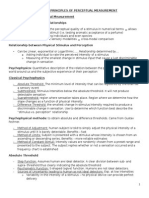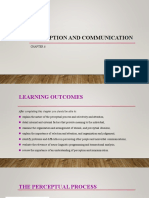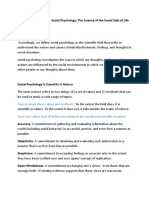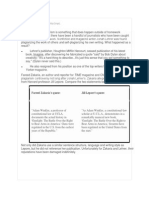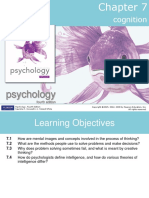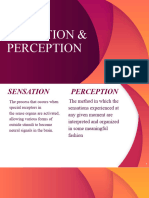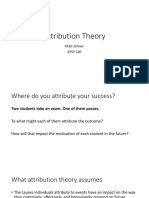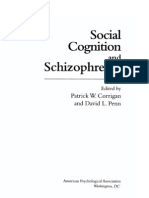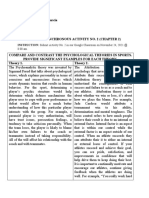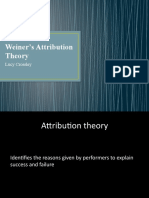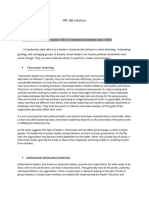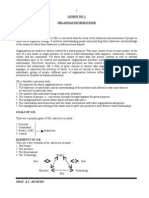Cognitive Process
of Organizational
Behaviour
Perception and Attribution
EMG 371-2/3
�Learning Objectives
Define the overall nature of perception,
explaining how it differs from sensation
Discuss perceptual selectivity and
organization
Identify the dimensions of social perception,
including stereotyping and halo
Explain the attribution process
9/20/16
�What do you
see in this
picture?
9/20/16
�9/20/16
�9/20/16
�What is Perception?
Perception is the process of receiving
information about and making sense of the
world around us. It involves deciding which
information to notice, how to categorize
this information and how to interpret it
within
the
framework
of
existing
knowledge
9/20/16
�Factors that influence on
Perception
Factors in the perceiver
Attitudes
Motives
Interests
Experience
Expectations
Factors in the situation
Time
Work Setting
Social Setting
Perception
Factors in the Target
Novelty
Motion
Sounds
Size
Background
Proximity
Similarity
9/20/16
�Sub processes of Perception
External
Environment
Confrontation
Physical
Environme
nt
Sociocultural
Environment
Registration
Feedback
Consequences
9/20/16
Interpretation
Behavior
�Principles of Perceptual Selectivity
External Selection Factors:
Intensity: The more intense the external
stimuli, the more likely it will be perceived.
Size: larger the object, the more likely it
will be perceived.
Contrast: External stimuli that stand out
against the background or that are not
what people are expecting will receive
their attention.
9/20/16
9
�Principles of Perceptual Selectivity
Repetition: A repeated external stimulus is
more attention getting than a single one.
Motion: People pay more attention to moving
objects in their field of vision than they will
hold to stationary objects.
Novelty and Familiarity: Either a novel or a
familiar situation can serve as an attention
getter.
9/20/16
10
�Principles of Perceptual Selectivity
Internal Selection Factors:
Internal perceptual selectivity is more
complex.
Learning
Motivation
Personality
9/20/16
11
�Perceptual Organization
Perceptual
organization explains what
takes place in the perceptual process once
the information from the situation is
received.
The persons perceptual process organizes
the incoming information into a meaningful
whole.
Gestalt psychology
9/20/16
12
�Principles of perceptual
organization
Figure ground
This principle says that background and the
perceived object are identified separately.
Perceptual grouping
There is a tendency to group several stimuli
together into a recognizable pattern.
This grouping is done by closure, proximity
or similarity.
9/20/16
13
�Figure - Ground
9/20/16
14
�Figure - Ground
9/20/16
15
�Principles of perceptual
organization
Figure ground
This principle says that background and the
perceived object are identified separately.
Perceptual grouping
There is a tendency to group several stimuli
together into a recognizable pattern.
This grouping is done by closure, proximity
or similarity.
9/20/16
16
�Principles of perceptual
organization
The principles used in grouping are:
Closure: The persons perceptual process will
close the gaps that are unfilled in sensory
input
Continuity:
Continuity principle says a
person will tend to perceive continuous lines
or patterns
Proximity: A group of stimuli that are close
together will be perceived as a whole pattern
of parts belonging together
Similarity: The greater the similarity of the
stimuli, the greater the tendency to perceive
them as a common group (Minority, Women) 17
9/20/16
�Closure
9/20/16
18
�Continuity
9/20/16
19
�Proximity
9/20/16
20
�Similarity
9/20/16
21
�Principles of perceptual
organization
Perceptual constancy:
Individuals have a sense of constancy in a
tremendously variable and complex world.
The size, shape, color, brightness, and
location of an object are fairly constant
regardless of the information received by
the senses.
Perceptual context:
Context gives meaning and value to stimuli,
9/20/16
objectives events, and others persons in the
environment.
22
�Social perception
Social Perception is concerned with how one
individual perceives other individuals:
How does one get to know others.
How people perceive others in their day to day
to life?
Some of the research findings related to social
perception are:
One's
own
characteristics
affect
the
characteristics one is likely to see in others.
Person who evaluate themselves favorably are
9/20/16
more likely to be able to see favorable aspects23
�Problem areas related to
social perception
Stereotyping
Stereotyping is perceiving a persons based on the
group in which he is a member
Such groups can be supervisors, knowledge
workers, old persons, women, different religions
etc
The real individual traits and characteristics of a
person are ignored and a set of traits thought to
be exhibited by a group are perceived instead.
Halo Effect
In halo effect, the person is perceived based on
the basis of one trait exhibited by him
9/20/16
24
�What is Attribution?
Attribution refers to how people explain
the cause of anothers or their own
behavior
The determination depends on three
factors:
Distinctiveness
Consensus
Consistency
9/20/16
25
�Types of Attributions
Insert Figure 4.3 here
9/20/16
26
�Attribution Theory
9/20/16
27
�Attribution Errors
Fundamental attribution error
overestimating the personal causes for others
behavior while underestimating the situational
causes
Self-serving bias
attributing personal success to internal factors
and personal failure to external factors
9/20/16
28
�Thank You
9/20/16
29











